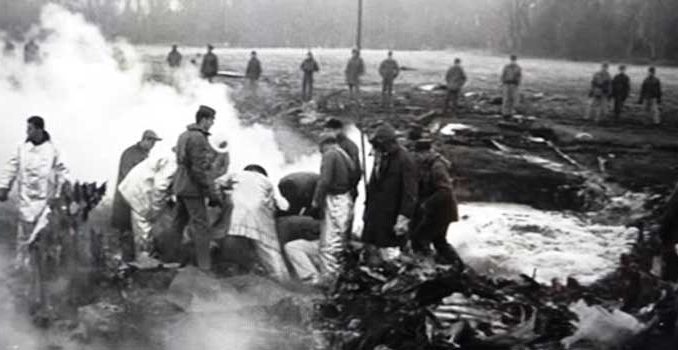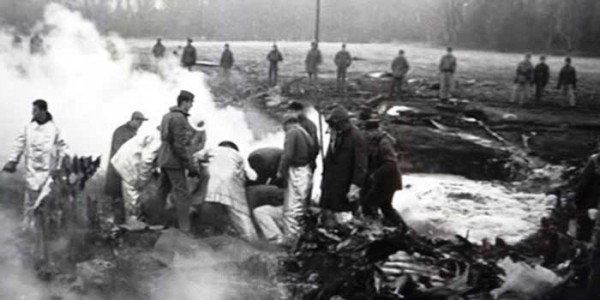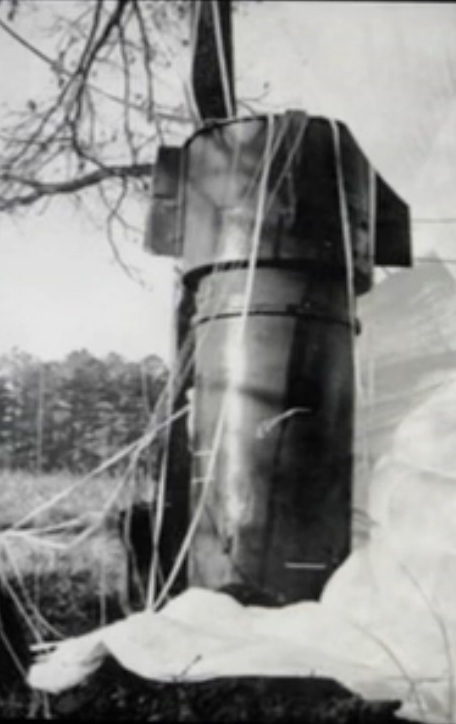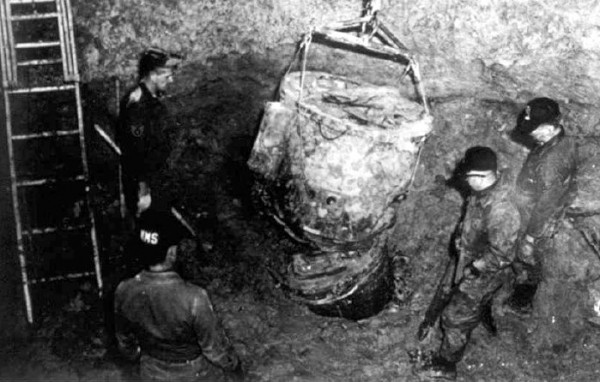

Broken Arrow: two simple words which seem innocent enough, but when one knows they represent the code-word for a lost nuclear weapon, they are perhaps the scariest words you could ever contemplate. Given all the safeguards our military enacts to prevent such a thing from happening, it might surprise many to learn that there have been a few Broken Arrow cases over the years. Perhaps the most frightening Broken Arrow incident occurred over Goldsboro, North Carolina in 1961 when a B-52G bomber, carrying two massive Mk. 39 hydrogen bombs, came apart following structural failure in the right wing. The two 250 Megaton H-bombs spilled out of the shattered Stratofortress, tumbling to earth and partially arming themselves in the process. What happened next could easily have lead to global nuclear war if only a few things came out differently. This riveting story is told, with extensive additional details in Joel Dobson’s The Goldsboro Broken Arrow, 2nd Edition released in recent weeks.

Joel Dobson is a former Air Force officer who served in the Strategic Air Command during the 1960’s. His book describes the true story of the events behind that fateful B-52 mission at the build-up of SAC during the Cold War. It also tells of the potential aftermath, in the words of some experts, the largest man-made disaster in history—a huge nuclear explosion on American soil. Eyewitnesses to the crash at Faro have unique stories to tell, as well as the sole living member of the crew who miraculously survived without an ejection seat—a feat that fellow pilots say was not possible. There is also the story of the man who deactivated both 3.8 megaton monsters… One hanging from a tree by its parachute, the other buried in the ground. In 1983, Secretary of Defense Robert McNamara said of the Goldsboro bomb, “It ran through six or seven steps in order to detonate, and it went through all but one.”
In a quote from the book: “How close was it to exploding? My opinion is damn close. You might now have a large Bay of North Carolina if that thing had gone off,” said Dr. Jack B. ReVelle. He was the Explosive Ordnance Disposal officer who deactivated both thermonuclear bombs in 1961. If a detonation had occurred, it could have been the ‘tipping point’ of the closest we have ever been to accidental nuclear war.
As Dobson surmises, it is very possible that in the fog of the Cold War, any accidental nuclear detonation would have been misidentified not as a terrible accident, but as an enemy attack. The Commander-In-Chief of SAC at that time was General Thomas Power, who had the ‘pre-delegated authority’ to launch the nuclear force on his own if only two events occurred: a nuclear attack on America; and lost communications with the Joint Chiefs of Staff. Communication weaknesses such as the effects of EMP (electromagnetic pulse) were still being discovered at that time, so there was indeed at least a possibility that the ‘perfect storm’ was in place—near Goldsboro, North Carolina, in 1961….SAC’s airborne alert had just started: armed B-52s were in the air around the clock…and a commander with both the authority and the personal desire to go to preemptive war was in command of SAC, history’s greatest nuclear force.

This second edition of Dobson’s book has a lot of revisions due to freshly discovered details. For those who already own the first edition, who might be wondering what has been added to the latest version, Joel Dobson recently told Warbird News that…
If you are interested in buying this book you can purchase it on Amazon, click HERE.



This is a remarkable story. I saw an interview with Mr. Dobson a few months ago on C-Span. I had never heard about this incident. My father was stationed at Seymour Johnson AFB not too long after this incident, (1963) and was in fact a member of Airborne Command Post; the SAC military alert unit mentioned in the article. It is frightening to know how close we came to a nuclear disaster. Chernobyl pales in comparison.
The cold war was truly COLD. The amount of close calls is unbelievable.
COMMAND AND CONTROL
Nuclear Weapons, the Damascus Accident, and the Illusion of Safety
By Eric Schlosser
another excellent book on various accidents involving nuclear weapons.
The documentation used by Dobson and Schlosser was previously published in two books by myself and James C. Oskins in “Broken Arrow, The Declassified History of US Nuclear Weapons Accidents” in 2007 (ISBN-13: 978-1435703612), and “Broken Arrow, Volume II” (2010) ISBN-13: 978-0557655939. Both Dobson and Schlosser contacted me asking to use our research material for their books; I find it rather amusing that they claim the documents in their books, previously published in our works, were the result of their own FOIA requests.
The two Mark 39 Mod 2 bombs at Goldsboro were not in any danger of producing a nuclear yield. The Mk 39 had two electrically operated solenoid safety switches which could only be moved from “safe” to “arm” via two physically separate crew members (pilot and bomb nav) via the aircraft monitoring and control equipment (using a specific voltage and amperage). Electrical power from the bomb’s low voltage and high voltage thermal batteries could not bypass these switches, as was designed, and there were several other components that had to be activated prior to weapon release. Declassified documents show that the 39 required at least nineteen steps by the aircrew to supply power and release the weapon for an intentional burst, and six additional processes for the bomb to fire, to include rotation of the Arm/Safe switch to arm, rotating the Rotary Safing Switch to “arm”, remove X-unit ground, charging of the X-unit, charging spark gaps, and firing of the tritium reservoir. None of the steps occurred, and while the safety devices were not as advanced as today’s, they functioned as designed.
The weapon that Lt. Revelle rendered safe could not have produced a nuclear yield, since the high voltage thermal battery never functioned (it is used to charge the X-Unit). Additionally, the damaged MC-772 he located was in the “safe” position as shown in a subsequent AEC post mortem. As cited above, much more was required for a weapon to detonate (whether through accident or design), and the bombs at Goldsboro could not have produced a nuclear yield.
Our books contain the original aircraft accident reports, along with declassified AEC, DOD, and DOE photographs, drawings, and first hand accounts on weapon accidents and incidents from 1945 onward.
Yours,
Michael H. Maggelet, USAF Retired
Nuclear Weapons Specialist (1980-1995)
everyone wants in the act and is an expert, like this guy. I wonder why he thinks Maj. ReVelle developed luckemia and evntual cancer.
Feel free to educate the public on the accident using your vast insight (if you even have any experience in the nuclear weapons field). Mr. Revelle was not exposed to any plutonium hazards at Goldsboro; the weapon did not contain plutonium. He may have been exposed to plutonium oxide at other accident sites (that, and Agent Orange and herbicide exposures in Vietnam).
I’ll be waiting for your response.
We never had 259 MT weapons. That weapon was 3 to 4 MT.